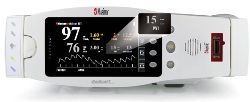A recent clinical study that was published in the Anesthesia & Analgesia has proved that the Masimo PVI is able to predict successfully the hemodynamic effects due to positive end-expiratory pressure (PEEP) for mechanically ventilated patients who have recently undergone cardiac surgery.
 Masimo PVI
Masimo PVI
This ability to predict PEEP effects by the PVI will facilitate physicians in optimizing the respiratory oxygen uptake and subsequent delivery of oxygen to the tissues, according to the researchers who conducted the study.
It is vital for clinicians to precisely find out if the inclusion of the PEEP is able to change the cardiac output, and result in either positive or negative hemodynamic effects. PEEP will be beneficial if it improves oxygen supply to the arteries and harmful if it reduces blood flowing in the tissues that is usually measured in terms of cardiac output. Various clinic studies have proved that Masimo PVI is able to predict noninvasively and continuously the responsiveness of fluid in mechanically ventilated patients who are under general anesthesia. However, researchers involved in the study considered the relation between fluid responsiveness and the PVI in a reverse methodology from where the evaluation is normally done. They analyzed if the PVI could forecast a reduced preload or a negative response with the inclusion of the PEEP.
Researchers from the School of Medicine in Irvine, California, the University of California, Irvine, and the Louis Pradel Hospital, Department of Anesthesiology and Intensive Care, in Lyon, France, examined 21 sedated and mechanically ventilated patients during the postoperative period subsequent to the coronary artery bypass graft (CABG) surgery. They monitored these patients through invasive pulmonary artery catheter for end-expiratory central venous pressure (CVP), PVI through a Masimo Rainbow SET Pulse CO-Oximeter sensor fixed to the finger, stroke volume (SV) and pulse pressure variation, cardiac index and end-expiratory pulmonary capillary wedge pressure (PCWP). The researchers noted the hemodynamic data for three successive tidal volumes (VT of 6, 8, and 10 mL/kg) at zero end-expiratory pressure (ZEEP) and after the 10 cm H2O PEEP was added for every VT. They classified the hemodynamically instable (HI) patients as the ones experiencing more than 15% decrease in CI after the PEEP was added.
The HI group of patients had a remarkably higher PVI in comparison to the patients in the non-HI group. The HI group patients experienced higher pulse pressure variations than the ones in the non-HI group. The researchers deduced that the Masimo PVI could be useful for noninvasive and automated detection of the hemodynamic effects of PEEP when the VT is more than or equal to 8 mL/kg in sedated and ventilated patients with permitted specificity and sensitivity.
The study reinforces the importance of PVI in comparison to invasive measures and stresses the value of PVI to reliably detect the hemodynamic effects due to PEEP and also forecast the hemodynamic instability. PVI is a component of Masimo Rainbow SET Pulse CO-Oximetry that is an innovative, noninvasive monitoring platform for the measurement of multiple constituents of blood, which earlier needed invasive methods. Such methods include total hemoglobin, carboxyhemoglobin (SpCO), oxyhemoglobin (SpO2), pulse rate (PR), oxygen content (SpOC), methemoglobin (SpMet), and PVI.